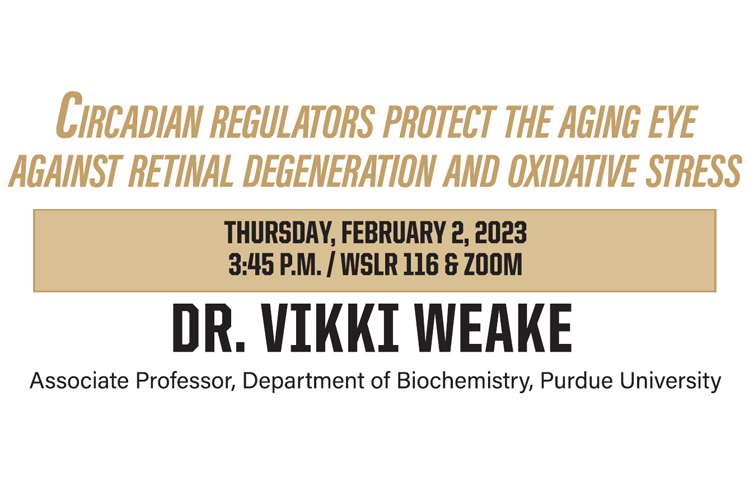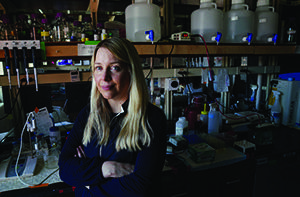
DEPT OF ENTOMOLOGY SEMINAR | DR. VIKKI WEAKE
Purdue University
FEBRUARY 2, 2023 | WSLR 116 & Zoom | 3:45-5:00 P.M.
 Studies in multiple organisms have shown that aging is accompanied by several molecular phenotypes that include dysregulation of chromatin. Since chromatin regulates DNA-based processes such as transcription, alterations in chromatin modifications could impact the transcriptome and function of aging cells. In Drosophila melanogaster, as in mammals, the aging eye undergoes changes in gene expression that correlate with declining visual function and increased risk of retinal degeneration. However, the causes of these transcriptome changes are poorly understood. To identify the gene regulatory mechanisms that drive age-associated changes in the light-sensing photoreceptor neurons within the eye, we integrated ATAC-seq and RNA-seq data over multiple time points using a cell type-specific approach based on nuclei tagging. This approach identified changes in the activity of two master circadian transcription factors, Clock and Cycle, in aging photoreceptors. The circadian clock maintains daily biological rhythms by controlling expression of target output genes, and is highly conserved between Drosophila and humans. Although the eye is not required for circadian behavior in flies, many genes are rhythmically expressed in the retina including most of the phototransduction machinery, and the retina provides input signals to synchronize the molecular clock with daily light exposure. When we disrupted Clock and Cycle activity by expressing a dominant negative version of Clock in adult photoreceptors, we observed premature light-dependent retinal degeneration, suggesting that these transcription factors play a neuroprotective role in the aging eye. In addition, disrupting the circadian clock resulted in widespread changes in expression of photoreceptor genes including key components of the phototransduction machinery and many eye-specific transcription factors. Disruption of Clock and Cycle was also accompanied by progressive decreases in global chromatin accessibility and changes in transcription factor activity, suggesting that Clock and Cycle act as master regulators of the adult photoreceptor gene regulatory network in part by regulating transcription factor expression. Our data suggests that the circadian regulators Clock and Cycle act as neuroprotective factors in the aging eye by directing gene regulatory networks that maintain expression of the phototransduction machinery and counteract oxidative stress. Based on new data from our ongoing studies, we propose that the age-associated changes in the circadian clock are driven largely by changes in levels of specific chromatin marks, consistent with the model that chromatin dysregulation is a key contributor to age-associated phenotypes in the eye.
Studies in multiple organisms have shown that aging is accompanied by several molecular phenotypes that include dysregulation of chromatin. Since chromatin regulates DNA-based processes such as transcription, alterations in chromatin modifications could impact the transcriptome and function of aging cells. In Drosophila melanogaster, as in mammals, the aging eye undergoes changes in gene expression that correlate with declining visual function and increased risk of retinal degeneration. However, the causes of these transcriptome changes are poorly understood. To identify the gene regulatory mechanisms that drive age-associated changes in the light-sensing photoreceptor neurons within the eye, we integrated ATAC-seq and RNA-seq data over multiple time points using a cell type-specific approach based on nuclei tagging. This approach identified changes in the activity of two master circadian transcription factors, Clock and Cycle, in aging photoreceptors. The circadian clock maintains daily biological rhythms by controlling expression of target output genes, and is highly conserved between Drosophila and humans. Although the eye is not required for circadian behavior in flies, many genes are rhythmically expressed in the retina including most of the phototransduction machinery, and the retina provides input signals to synchronize the molecular clock with daily light exposure. When we disrupted Clock and Cycle activity by expressing a dominant negative version of Clock in adult photoreceptors, we observed premature light-dependent retinal degeneration, suggesting that these transcription factors play a neuroprotective role in the aging eye. In addition, disrupting the circadian clock resulted in widespread changes in expression of photoreceptor genes including key components of the phototransduction machinery and many eye-specific transcription factors. Disruption of Clock and Cycle was also accompanied by progressive decreases in global chromatin accessibility and changes in transcription factor activity, suggesting that Clock and Cycle act as master regulators of the adult photoreceptor gene regulatory network in part by regulating transcription factor expression. Our data suggests that the circadian regulators Clock and Cycle act as neuroprotective factors in the aging eye by directing gene regulatory networks that maintain expression of the phototransduction machinery and counteract oxidative stress. Based on new data from our ongoing studies, we propose that the age-associated changes in the circadian clock are driven largely by changes in levels of specific chromatin marks, consistent with the model that chromatin dysregulation is a key contributor to age-associated phenotypes in the eye.
Check out the Weake Lab!